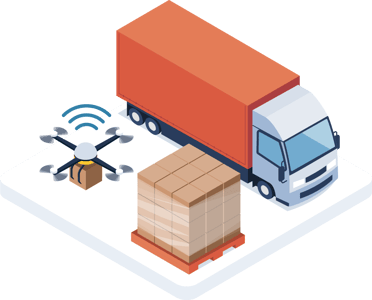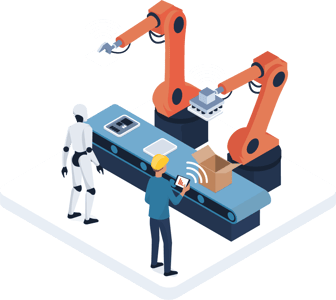
Table of contents
- Logistics as a response to new consumer habits
- The Chinese model: in search of maximum efficiency
- A new technological boost: robots and automation systems
- Does total efficiency imply dehumanization of the supply chain?
Achieving efficient product inventory management leads to punctual deliveries and therefore to satisfied and loyal customers, which is the highest goal of any online business.
When assessing whether in logistics services ecommerce companies prefer good quality or low cost, in recent years we have seen a departure from low cost systems while 74% of retailers prefer a good cost-quality balance.
However, it’s very tempting to seek maximum cost savings, at any cost (depending where cuts are implemented, they may not cause a compromise in quality in the supply chain, so much as in other human factors involved).
Logistics 4.0 is here.

Logistics as a response to new consumer habits
Logistics 4.0 is a technological approach that seeks to optimize the operation and performance of all phases involved in the product distribution process:
- Supply chain management logistics: A more flexible, accessible and global cloud network.
- Inbound logistics: Predictions from big data.
- Warehouse management: Automated checking.
- Intralogistics: Autonomous Guided Vehicles (FTS).
- Outbound logistics: Predictive shipment management.
- Transport and delivery logistics: Autonomous vehicles and equipment.
Companies with an ecommerce presence treat their Logistics 4.0 plans as a commitment to internal efficiency. But in reality, this impulse to optimize the speed and costs of storage and shipping is just as much to do with consumers.
Changes in demand becoming ever more agile, requires companies to make a rapid rotation of their product catalog with constant updates and releases. In addition, this implies that the demand seeks instant satisfaction, and express shipments are increasingly called for. And not only for products that come from the other side of the world, but for consumable goods that you want to receive in less than an hour.
→ This may interest you: The possibilities of ecommerce in the future of autonomous transport
Demand takes off: more and faster deliveries
China is the biggest example of this boom of consumption through ecommerce. This year, up to 71 billion parcels will be distributed across the country, and according to eMarketer the revenue from Chinese ecommerce will reach USD 2.5 billion by 2020.
Among the Chinese population, ecommerce has become an everyday ally: online orders are placed for everything, even a coffee, such as the Luckin Coffee chain that has forced Starbucks to include home deliveries in its strategy. Something still unthinkable in the West, where the greatest logistical breakthrough in ecommerce so far, is to be able to make your order and pick it up without queuing in the store.
In the home food sector alone the numbers in China are gigantic: the Meituan chain has 400 million users, 5 million affiliated restaurants, 600,000 couriers and an average of 20 million orders per day.
It’s quite obvious that to effectively meet demand it’ll be necessary to build a faster network than the one used so far, and the answer to that lies in technology, which can reduce the logistical costs of companies and improve user satisfaction:
- Transport free of delays
- Monitoring of merchandise
- Prevention of theft
- Eliminating management errors
- Reducing mistakes in IT

The Chinese model: in search of maximum efficiency
In China, a business culture has taken hold within ecommerce that is fiercely competitive and strives for the largest messaging network, the fastest speed and the most advanced logistics.
Interestingly, logistical costs in China stand well above average, occupying 14.6% of annual GDP (compared to 7.7% in the United States).
Although demand and delivery figures are available, entrepreneurs and logistics chains are still fighting to achieve a model that will reduce costs without giving up their agility of performance.
The battle has even led to Amazon giving up competing on the Chinese market, where the application of technology is advancing at a faster pace than in other regions of the world.

A new technological boost: robots and automation systems
Logistics 4.0 is developing IoT (Internet of Things) applications to foster a smarter, globally connected and technologically advanced management network.
These are some of the most interesting and relevant fields of logistics technology for ecommerce:
Artificial intelligence
In China they already use artificial intelligence to calculate the best delivery route in merely 0.55 milliseconds.
Cobots
In logistics we don’t talk about robots so much as cobots: collaborative robots. In this system, machines and people work side by side, with applications in each of the manufacturing, logistics and transport phases. Amazon took one of the first steps by acquiring Kiva Systems, now Amazon Robotics; while LocusBots is working with global transportation companies such as DHL.
Drones
Popular belief has drones typecast in the role of distributing packages to remote locations (and sometimes causing attention-grabbing accidents). But apart from their use as couriers, drones have an important application in warehouse and inventory management. With the support of drones, each worker can manage up to 1,200 products per hour.
Autonomous vehicles
While users remain skeptical about drones, courier companies are studying the use of autonomous distribution vehicles for short and long distances, such as Neolix in China.

Cloud storage
Saving, editing, and distributing product information in the cloud helps to eliminate three of the main logistics problems of present-day ecommerce: reducing data silos, overcoming outdated management, and getting rid of spreadsheets once and for all. The important step that companies are already taking is to use Product Information Management (PIM) software systems, like the one our team at Sales Layer is developing continually in order to improve our artificial intelligence capabilities and services.
→ This may interest you: PIM, the key to multi-channel sales success
Automated inventory
You no longer need to waste time with manual checks, taking down boxes and opening them: smart containers and shelves have arrived. Here, each product carries a code that can be read automatically so that the items can be sorted into into boxes, which are in turn identified by chips. These chips can simply be read by a drone.
Blockchain
This system facilitates the smart distribution of information and the development of contracts and transactions that are more secure, faster and more efficient.
GPS Sensors
These monitor shipping values, such as temperature and humidity, in fresh food, pharmaceuticals or beverages, to prevent spoilage in transport or during storage. Furthermore, for transport of goods on land, sensors that can foresee derailments and thus prevent accidents are being installed on railroad tracks.

Does total efficiency imply dehumanization of the supply chain?
Stock and shipment management by drones arouses a universal concern: does it mean that machines will replace human workers?
By pursuing maximum efficiency and reduction in costs, the machine is always going to be superior to human management. A drone can read up to 600 boxes in an hour, without opening them to check their contents, and with ease of accessing high shelves. This greatly increases the possibilities of vertical storage and solves one of the biggest logistics problems: space.
For example, demand for warehouses in China has soared to 60 million sq. m in 2019. This is why some warehouses already use robotic vertical walls up to 24 meters high to make the most of the space. Managing such a space is already impossible for a human.
Companies providing logistics for ecommerce recognize that the current level of technology doesn’t allow for more efficiency. It will be necessary for those technologies applicable to the IoT, to continue improving if we are to see any substantial increase in performance.
→ This may interest you: How to use Fulfillment by Amazon services
Towards a human-friendly technology
Despite the forecasts, these logistics chains insist that rather than jobs being destroyed, more are being created every year to manage machine activity. In addition, the human factor remains indispensable for implementing cybersecurity measures, which ensure a secure exchange of data among those involved as well as for the owners of the information (a problematic issue in China).
Logistics 4.0 may well allow faster decisions to be made, but to avoid leaving such decisions to the machines themselves is the smart way forward, and the key is to retain supervision by human managers and planning carried out by people. Obtaining the latest model of a given device is not enough, but rather, we must learn how to interpret the data it provides, relate that to other variables and apply it to strategic decisions.
For this reason, at Sales Layer we support and develop technology that facilitates access to complex systems and streamlines product information management. Try our PIM for free for 30 days and enjoy your first step towards the revolution in ecommerce efficiency.



.png?width=520&name=Blog%20Partner%20(3).png)

.png?width=520&name=Blog%20Partner%20(1).png)


